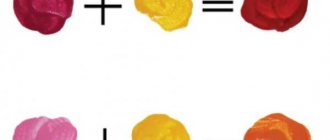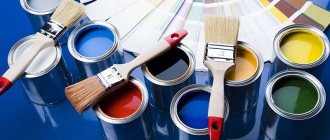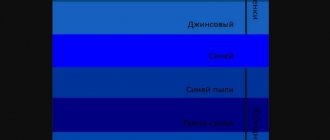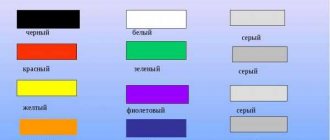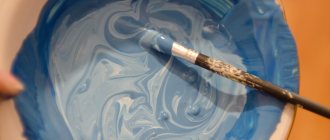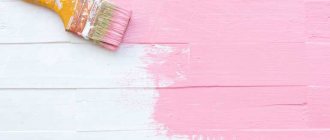When painting pictures, situations often arise in which the required shade runs out or is missing from the palette. Because of this, novice artists have a question about how to get a purple color when mixing gouache, watercolor and other paints. At first glance, this is easy to do, just look at the combination table and mix 2 other colors. But in the process, questions often arise that require a deeper study of the issue.
What tools are needed?
To work you will need the following tools:
- Palette. Preferably white, as a colored surface can distort the shades. Models made of plastic or materials with similar properties are best suited.
- The basic set of colors is red, blue, yellow, green, white and black.
- Tassels.
- A glass or small jar of water. The liquid must be changed periodically to prevent the brushes from clogging.
- Canvas draft. You can use it to check how well the smear will fit.
If you don’t have a palette, you can replace it with a glass, plate, bowl, special mixing bowl, or any other glass or plastic container.
It is important that all tools are clean and free of traces of previously used paints.
Shade table
For a more clear and visual examination of shades of purple, a table of mixing colors and the results obtained is provided.
| Bottom line | Mixable paints |
| Lilac | Blue + pink |
| Iris | Dark blue + bright red |
| Indigo | Blue + black |
| Purple | Red+blue+green |
| Lilac | Red + Blue + Green + White |
| Eggplant | Dark blue + scarlet |
| Bilberry | Purple + black |
| Lavender | Gray + purple |
| Plum | Purple + red |
| Grape | Blue + red |
| Amethyst | Lilac + red |
| Glycine | Blue + gray |
| Fuchsia | Red + indigo + lilac |
| Orchid | Red + blue + water |
| Blackberry | Purple + black |
| Violet | Purple + white |
This chart gives the base colors needed to create new shades. It should be noted that the previously stated ratios are rather arbitrary. You have to choose the right proportion yourself. After all, the result obtained depends on the initial quality of the suspension, its consistency, date of manufacture and expiration date. Create, fantasize and get new variations of the shade of purple.
Share link:
Getting the color
To get different shades of purple, you need to mix red paint with blue. However, you should avoid yellow and all shades containing it, otherwise the result will be a dirty brownish or gray undertone. When mixing, you should pay attention to the saturation and purity of red and blue - the characteristics of the final color depend on them.
If the set of paints already contains pure purple, then it is better to use it to create shades.
The resulting colors will be richer and less faded than those created by mixing red with blue.
Regular purple
The standard purple color is made by mixing blue and red in a 2:1 ratio. Then different shades are created from this base, adding black, white, pink, blue and other tones.
Light purple
The easiest way to achieve a light purple tone is by adding white to the base. White is gradually added to the main color until the desired result is achieved, periodically checking the result on the palette. The maximum ratio of white to base is 1:5, otherwise the main color may be lost.
If you need to lighten the tone slightly, you can dilute the purple paint with water. This helps keep it richer and more natural. It is worth considering that you can only mix light colors on a white palette, since a wooden or painted surface distorts them.
You can get unusual shades of light purple (thistle, lilac, wisteria) by mixing blue and pink. The first color is taken as a basis, then the second is gradually introduced. Cooler shades of pink produce pale tones of light purple, while warmer shades add brightness.
If you add a little red to the resulting lilac color, you will get a nice light amethyst color. By adding blue you can achieve bright berry undertones.
Dark purple
A darkened purple hue is created by mixing dark blue and bright red. The first color “absorbs” the warmth and richness of the second, resulting in a dull eggplant color. It can be made a little brighter by increasing the proportion of red, but this will not completely change the situation.
An unusual version of dark purple is created by mixing red paint with black. The second one is added quite carefully, in small droplets, otherwise the tone will become dirty.
A brighter dark purple comes from a mixture of red, indigo and lilac. Saturation and tonality depend on the proportion of colors; you can select it at your own discretion.
How to get lilac when mixing paints, gouache?
Achieving the desired effect in the process of combining paints seems simple only at first glance, including this applies to purple shades. Most colors can “absorb” others, while dominating the resulting shade, therefore, it is worth gradually introducing new colors and mixing very well, as described above. Professionals perform this work directly on the canvas, but if you are in doubt, it is better to do it on a ceramic plate or a special palette.
- Despite the fact that purple is not considered a basic color, it has quite a lot of pop-up colors, and as a result of introducing additional colors to the main colors or directly to purple, you can get almost 200 different shades of this color, ranging from white-lilac, finishing to deep purple. Guessing the correct proportions of the desired colors is the main problem, because... the transition from one shade to another has a very fine line.
Creating Lilac Color
- Traditionally, the lilac shade, as well as the main purple, are considered cool colors, and, of course, the initial stage of production is considered to be mixing blue and red colors.
- Lilac color is easy to obtain; to do this, add white to the “regular” violet color, which is made from cold blue and cold red.
- Lilac color belongs to the third group, because you can get it by combining 2, or even 3 or more colors.
If, as a result of manipulations with tones, you get a lilac color that sets off a red or pink tint, while you need a cold shade of lilac, this problem can be easily corrected, just add a small amount of black to the resulting mixture, which, after mixing, will absorb the redness.
How to adjust the resulting color
The purple palette has many shades, each of which is used in painting or decoration. To get the desired tone by mixing paints, you need to make a correction. Her rules:
- White will help lighten the tone and shift it towards pastels. Watercolors and similar paints can also be diluted with a small amount of water. But it is important not to overdo it with the liquid, otherwise you can ruin the paper or get unpleasant watery stains on the canvas.
- Adding black will help darken the purple, but it must be added carefully or the mixture will completely lose color and clog to a dark gray. Using dark indigo will help avoid this.
- You can get delicate lavender shades by adding gray to purple.
- To add richness to the color, add a small amount of warm pink. By changing the proportions and concentration, you can get grape, amethyst and other shades.
- By remixing purple with red, you can get dark tones such as wine, berry, and eggplant.
- Adding blue or indigo will help darken the purple a little. The result is a cool but rich shade, suitable for painting night landscapes.
- To get a bright plum, take a dark purple and dilute it with a pure red.
- By adding a little cyan to violet, the tone can be shifted towards blue without additional darkening. The resulting color is lightened with white if delicate lilac-bluish undertones are needed.
When correcting purple, it is important to keep your brushes and working surface clean.
The smallest particles of other paint can ruin the entire work, clogging the paint with brown or gray specks. To avoid this, instruments must be washed thoroughly after each use.
Adviсe
The purple palette includes many different shades used in decoration and painting. To achieve a certain tone when mixing paints, it is necessary to carry out correction.
For these purposes, it is recommended to use the following tips:
- To achieve lavender colors, it is permissible to mix gray with purple.
When creating a landscape, purple can be replaced with blue
- To depict a night landscape on canvas, purple can be slightly darkened with indigo or blue. The result is a cool but bright shade.
- To achieve a juicy plum, dark purple should be diluted with pure red.
- To bring blue without auxiliary darkening to violet, it is allowed to add a minimum amount of blue. It is permissible to lighten the finished shade with white if a delicate bluish-lilac color is required.
- If you combine reddish with purple for the second time, dark shades will come out in the form of eggplant, berry and wine.
- Black needs to be introduced little by little, because it can darken the purple. As a result, the composition will lose its shade and become dark gray. To prevent such a situation from occurring, it is better to use dark indigo.
Adding pink will make purple tones warmer
- To make the shade more juicy, you need to include a minimum amount of warm pink. When changing the saturation and ratio, a grape and amethyst tone emerges.
When mixing purple, be sure to monitor the cleanliness of the working surface and brushes. The entire work can be ruined if small particles of other paint get in. As a result, the color will be clogged with gray or brown inclusions. Therefore, every time the instruments need to be rinsed well with water.
Features of working with different paints
When mixing tones, you need to take homogeneous paints that are identical in quality and texture, otherwise the result will be blurry and of poor quality. Therefore, it is advisable to use tubes from the same set: they fit together as closely as possible. Other nuances of mixing depend on the type of paint, its thickness, oiliness, wateriness, saturation and other parameters.
Oil paint
Oil paints are the most difficult to mix due to their viscous consistency and characteristic texture. You can do this in three ways:
- Mechanical or physical. The desired colors are mixed in a special container, using a base tone for adjustment. The result is a new shade. It is necessary to combine paints mechanically carefully, avoiding even the slightest homogeneous spots and untreated areas. This is the only way to achieve a clean, uniform tone.
- Overlay. Done directly on canvas. An additional thin, translucent layer is applied on top of the main tone. As a result, the illusion of mixing colors occurs, which allows you to obtain new shades in the picture. The technique is quite complicated to use and requires knowledge of glazing, so it is rarely used by beginners.
- Optical mixing. Strokes of different colors are placed as close to each other as possible and placed at a special angle, which allows you to achieve the illusion of merging. This technique allows you to get a uniform tone, but requires skill in drawing.
Most often, oil paints are mixed mechanically. The remaining 2 are used in the drawing process by experienced artists.
Acrylic paint
Acrylic paints are easier to mix than oil paints. The main tone is applied to the palette, after which an additional tone is introduced into it in small portions until the desired result is achieved. The color is then corrected using black and white. Since the exact proportions of acrylic are difficult to calculate, you need to combine shades gradually, periodically testing the result.
Acrylic tends to slightly change color when drying, so before applying a new shade it is advisable to make a control stroke on the canvas and wait for it to dry. This will help avoid mistakes when painting.
Gouache paint
Gouache should not be mixed on paper or the shade adjusted by diluting with water. New tones are obtained by combining two colors on a white plastic palette in a special plastic or glass container. First of all, the main color is applied to the surface - blue or cyan, then pink or red is mixed into it until the desired result is obtained. The resulting tone is lightened with white or darkened with a small amount of black (can be replaced with dark green).
When working with gouache, purple paint can be mixed with black and white at the same time if you want to get a dull, muted tone. To create a vibrant purple, you can add a little yellow to the mixture of red and blue.
Watercolor paint
Watercolors are mixed on a palette or paper. In the second case, you can make test strokes on a draft or merge during the drawing process. The paint is easily diluted with water, so light shades are most often obtained by adding liquid. Dark or bright versions of purple are achieved by adding red, black, pink, dark blue and other colors.
When mixing watercolors, you can use only clean paints that are not stained with streaks or blotches. Otherwise, the purple will come out dull or turn gray or brownish. Watercolor also quickly deteriorates, absorbing other colors, so it is advisable to correct shades with a minimum amount of impurities.
An easy way to get purple
In coloristics there is a simple method that allows you to produce a purple tone. To do this, you need to take red and blue watercolor or acrylic paint, gouache in equal proportions, and mix them together. The dyes must be mixed thoroughly so that no streaks remain. The depth and brightness of the resulting paint will depend on the tones of the original colors and the accuracy of calculating proportions. Sometimes the artist ends up with a purple color – it is very similar to violet, but has a more pronounced red tint.
What are the different shades of purple called?
There are about 200 varieties of purple (196 in the Pantone palette). Each of them is given a name - this is done for ease of orientation for artists, designers and specialists for whom understanding colors is important. The most common shades:
- purple;
- eggplant;
- indigo;
- lilac;
- violet;
- lavender;
- amethyst;
- lilac;
- thistle;
- pearl;
- fuchsia;
- royal purple;
- cuff;
- orchid;
- mov;
- crimson;
- grape;
- thundercloud;
- fig;
- plum;
- blackberry;
- cranberry;
- currant;
- orchid;
- iris;
- smoky lilac;
- peony;
- beet;
- phlox;
- heather;
- sparkling grapes.
In catalogs you can find more exotic shades of purple. Each of them is assigned a number in CMYK format (Cyan - blue, Magenta - magenta, Yellow - yellow, Key color - black), indicating the severity of certain tones. For simplicity, all shades are also given a simple name. Among them you can find quite unusual colors, such as “icy lavender”, “lilac snow” or “nostalgic rose”.
fireworks element
There are different types of fireworks in Minecraft. It is made from paper, gunpowder and a star, which affects the color, shape and nature of the fireworks explosion. And since there is a word “color”, it is quite logical to assume that the dye is applicable here too. Indeed, it is so. Purple dye, as a crafting ingredient, in a wide variety of combinations, either with gunpowder and a head, or with a feather and other items, will be needed to construct a pyrotechnic star.
Purple star
Purple star
Purple star
Asterisk (large ball)
